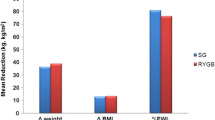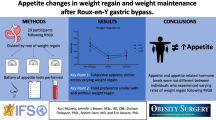Abstract
Among factors influencing the outcome of bariatric surgery may be genetics and familial risk. The purpose of this study was to assess the etiology of obesity and its impact on hunger, satiety, and food likes in obese patients undergoing Roux-en-Y gastric bypass (RYGB). This study was based on 76 patients undergoing RYGB procedures performed by a single surgeon. A previously described 100-point obesity risk index (ORI) was used to assess familial obesity risk. Hunger and satiety were assessed using a standardized Visual Analog Scale "Snickers" test, and food preferences for regular vs. low-fat potato chips were measured preoperatively and postoperatively. Patients were stratified preoperatively into high ORI (n = 34) and low ORI (n = 42) groups. Before operation, high-ORI patients preferred high-fat (regular) potato chips to low-fat (baked) potato chips, whereas the low-ORI patients liked both food types equivalently (P < 0.05). After operation (n = 43), both groups showed lower preferences for high-fat potato chips (P < 0.05 for high-ORI group). As anticipated, hunger was dramatically suppressed after RYGB. However, there was more satiety in the high-ORI group (P < 0.05, ANOVA). Most patients undergoing bariatric surgery had a strong familial or genetic component to their disease. RYGB in high-ORI patients was associated with a significant decline in preference of fatty food and a significantly prolonged drop in hunger ratings after a fast and after a standard 282 kcal meal. The success of bariatric surgery may be influenced by the etiology of obesity.
Similar content being viewed by others
References
Aitman TJ. Genetic medicine and obesity. N Engl J Med 2003;348:2138–2139.
Woods SC, Seeley RJ. Understanding the physiology of obesity: Review of recent developments in obesity research. Int J Obes 2002;26:S8-S10.
Rosenbaum M, Leibel RL, Hirsch J. Obesity. N Engl J Med 1997;337:396–407.
Corominola H, Conner LJ, Beavers LS, et al. Identification of novel genes differentially expressed in omental fat of obese subjects and obese type diabetic patients. Diabetes 2001; 50:2822–2830.
Chagnon Y, Perusse L, Weisnagel SJ, Rankinen T, Bouchard C. The human obesity map: The 1999 update. ObesRes 2000;8:89–117.
Sagar PM. Surgical treatment of morbid obesity. Br J Surg 1995;82:732–739.
Sugarman HJ, Starkey JV, Birkenhauer R. A randomized prospective trial of gastric bypass versus vertical banded gastroplasty for morbid obesity and their effect on sweets versus non-sweets eaters. Ann Surg 1987;205:613–624.
Thirlby RC, Randall J. A genetic "obesity risk index" for patients with morbid obesity. Obes Surg 2002;12:25–29.
Smith C. Recurrent risks multifactorial inheritance. Am J Hum Genet 1971;23:578–588.
Flickinger EG, Pories WJ, Meelheim D, Sinar DR, Blose IL, Thomas FT. The Greenville gastric bypass. Progress report at 3 years. Ann Surg 1984;199:555–562.
Capella JF, Capella RF. The weight reduction operation of choice: Vertical banded gastroplasty or gastric bypass? Am J Surg 1996;171:74–79.
Pories WJ, Flickinger EG, Meelheim D, Van Rij AM, Thomas FT. The effectiveness of gastric bypass over gastric partition in morbid obesity. Consequence of distal gastric and duodenal exclusion. Ann Surg 1982;196:389–398.
Bjorntorp P. Thrifty genes and human obesity. Are we chasing ghosts. Lancet 2001;358:1006–1008.
Bouchard C, Tremblay A, Despres JP, et al. The response to long term overfeeding in identical twins. N Engl J Med 1990;322:1477–1482.
Stunkard AJ, Harris JR, Pedersen NL, M cclearn GE. The body mass index of twins who have been reared apart. N Engl J Med 1990;322:1483–1487.
Stunkard AJ, Sorensen TIA, Hanis C, et al. An adoption study of human obesity. N Engl J Med 1986;314:193–198.
Stunkard AJ, Foch TT, Hrubec Z. A twin study of human obesity. JAMA 1986;256:51–54.
Bray GA, Popkin BM. Dietary fat intake does affect obesity. Am J Clin Nutr 1998;68:1157–1173.
Alford BB, Blankenship AC, Hagen RD. the effects of variations in carbohydrate, protein, and fat content of the diet upon weight loss, blood values, and nutrient intake of adult obese women. J Am Diet Assoc 1990;90:534–540.
Cox DN, Van Galen M, Hedderley D, Perry L, Moore P, Mela DJ. Sensory and hedonic judgments of common foods by lean consumers and consumers with obesity. Obes Res 1998;6:438–447.
Cox DN, Perry L, Moore PB, Vallis L, Mela DJ. Sensory and hedonic associations with macronutrient and energy intakes of lean and obese consumers. Int J Obes Relat Metab Disord 1999;23:403–410.
Freedman MR, King J, Kennedy E. Popular diets: A scientific review. Obes Res 2001;9:1S-40S.
Mela DJ. Determinants of food choice: Relationships with obesity and weight control. Obes Res 2001;9:249S-255S.
Westerterp-Plantenga MS, Pasman WJ, Yedema MJW, Wijckmans-Duijsens NEG. Energy intake adaptation of food intake to extreme energy densities of food by obese and non-obese women. Eur J Clin Nutr 1996;50:401–407.
Maskarinec G, Novotny R, Tasaki K. Dietary patterns are associated with body mass index in multiethnic women. J Nutr 2000;130:3068–3072.
Ogden J. The correlates of long-term weight loss: A group comparison study of obesity. Intl J Obes Relat Metab Disord 2000;24:1018–1024.
Ness-Abramof R, Apovian CM. An update on medical therapy for obesity. Nutr Clin Pract 2003; 18:145–155.
Bock MA. Roux-en-Y gastric bypass: The dietician’s and patient’s perspectives. Nutr Clin Pract 2003;18:141–144.
Cummings DE, Weigle DS, Frayo RS, et al. Plasma ghrelin levels after diet-induced weight loss or gastric bypass surgery. N Engl J Med 2002;346:1623–1630.
Faraj M, Havel PJ, Phelis S, Blank D, Sniderman AD, Cianflone K. Plasma acylation-stimulating protein, adiponectin, leptin, and ghrelin before and after weight loss induced gastric bypass surgery in morbid obese subjects. J Clin Endocrinol Metab 2003;88(4):1594–1602.
Grimsmo A, Helgesen G, Borchgrevink C. Short-term and long-term effects of lay groups on weight reduction. Br Med J (Clin Res Ed) 1981;283:1093–1095.
Feinstein AR. The treatment of obesity: An analysis of methods, results, and factors which influence success. J Chronic Dis 1960;11:349–392.
Williamson DF. Pharmacotherapy for obesity. JAMA 1999; 281:278–280.
Atkinson RL, Dietz WH, Foreyt JP, et al. Very low-calorie diets. JAMA 1993;270:967–974.
Shick SM, Wing RR, Klem M, McGuire MT, Hill JO, Seagle H. Persons successful at long-term weight loss and maintenance continue to consume low-energy, low-fat diet. J Am Diet Assoc 1998;98:408–413.
McGuire MT, Wing RR, Klem M, Lang W, Hill JO. What predicts weight regain in a group of successful weight losers? J Consult Clin Psychol 1999;67:177–185.
Guisado JA, Vaz FJ, Lopez-Ibor JJ Jr, Rubio MA. Eating behavior in morbidly obese patients undergoing gastric surgery: Differences between obese people with and without psychiatric disorders. Obes Surg 2001;11:576–580.
Author information
Authors and Affiliations
Corresponding author
Rights and permissions
About this article
Cite this article
Thirlby, R.C., Bahiraei, F., Randall, J. et al. Effect of roux-en-Y gastric bypass on satiety and food likes: The role of genetics. J Gastrointest Surg 10, 270–277 (2006). https://doi.org/10.1016/j.gassur.2005.06.012
Issue Date:
DOI: https://doi.org/10.1016/j.gassur.2005.06.012




